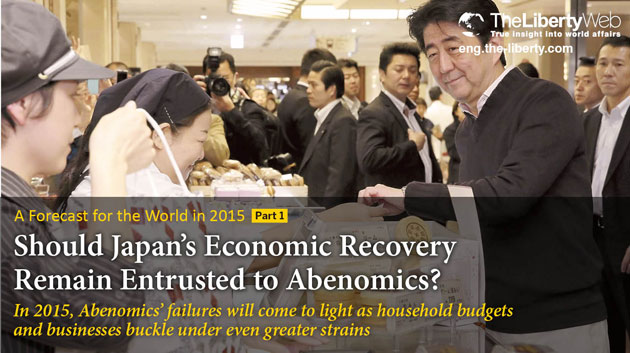Should Japan’s Economic Recovery Remain Entrusted to Abenomics?
What Will Come of Abenomics and Abe's Diplomacy?
On April 5th, the first weekend after the implementation of the consumption tax hike to 8%, Prime Minister Abe bought some Japanese confectionary at a department store in Tokyo while trying to encourage consumer spending. (pool photo)
Prime Minister Shinzo Abe announced his intention to postpone a planned consumption tax hike, and he dissolved the House of Representatives. However, it was the LDP that pushed the consumption tax increase forward to 10%, so it could be said that the LDP has performed its own work of “dissolution.” On the contrary, the Happy Realization Party (HRP) has consistently taken a stance against tax raises and has called for returning the consumption tax rate to 5%. Which party will really make the Japanese people happy? We will make a comparison of the two parties’ policies in terms of the economy and diplomacy.
A Forecast for the World in 2015
1. Should Japan’s Economic Recovery Remain Entrusted to Abenomics?
In 2015, Abenomics’ failures will come to light as household budgets and businesses buckle under even greater strains.
Prime Minister Abe vigorously announced a delay of the consumption tax hike, but it was the LDP that took a leading role in raising the tax rate in the first place. On the contrary, the Happiness Realization Party (HRP) has consistently stressed the importance of reducing tax rates, which has clearly shown that the HRP possessed foresight, but what are the differences between these two parties?
On November 18th, Prime Minister Shinzo Abe announced his intention to dissolve the House of Representatives to seek a voter mandate for the delay of an additional increase in the consumption tax to 10%.
Abe behaved as if he made some big decision, but it was the LDP that originally proposed the consumption tax hike to 10%. The party has now been trying to gain public support by postponing its own policy, but garnering approval by criticizing one’s own script reeks of hypocrisy.
The LDP Was Responsible for Pushing the Consumption Tax Hike Forward
In the summer of 2010, with the election of the House of Councils close at hand, the LDP stipulated a consumption tax increase to 10% in its manifesto. At that time, the Prime Minister of DPJ, Naoto Kan, said he was going to use the LDP’s plan to increase the sales tax as a reference. In the summer of 2012, under Noda DPJ’s administration, he passed a bill to raise the consumption tax into law with approvals from the LDP, the DPJ, and the Komeito. Obviously, the LDP paved the way for the tax hike to 8% and then to 10%. In fact, on the LDP’s website, it proudly declared, “The opposition party, the LDP, led the realization of the passage of the landmark bill to increase the consumption tax rate.”
Even though it might have made sense for the LDP to ask for the public’s opinion on the postponement of the tax hike to 10%, what about the waste of 4 years of discussions and all of the time and money spent on them? Who will take responsibility for it?
Moreover, the increase of the consumption tax rate to 8% in April wreaked havoc on Japan’s economy. In fact, the real GDP in the April to June quarter fell 7.3% on an annualized basis, which was a further decline than the one that Japan experienced at the time of the Great East Japan Earthquake, and it demonstrated the fact that the consumption tax hike has had a seriously negative impact on the economy.
When Prime Minister Abe postponed the tax hike, he declared his intention to delete an “economic conditions clause” in the current consumption tax law at the same time, and he stated that he will surely push the tax hike through to 10% after 18 months. His attitude in ignoring the economic situation has been very socialist in character.
The LDP’s Economic Policies Have Obstructed the Public’s Economic Activities
Of course, “Abenomics” has had some achievements that have deserved appreciation.
The first arrow was a bold monetary easing, a policy in which the Bank of Japan (BOJ) purchased government bonds that commercial banks had previously held, and it increased the amount of money in circulation and created an environment that encouraged every individual and business to get financing from the banks.
The second arrow was a flexible, fiscal stimulus package, a policy that increased public works and thereby bettered private capital investment and employment.
The first two arrows went smoothly, but when it came to the third arrow, the Abe administration stumbled on its growth strategy to energize the private sector.
Since April of last year, Abe has intermittently released plans for new growth strategies such as developing the medical sector into growing industries, establishing strong agriculture, forestry, and fishery industries, and promoting the acceptance of foreign medical doctors. However, they have been small in scale, and they’ve disappointed the market. Under such conditions, the government increased the consumption tax rate to 8%, which threw cold water on Japan’s economy that was initially showing some signs of improvement, and it resulted in a bigger drop in GDP than the one registered at the time of the 2011 Tohoku earthquake.
The LDP immediately implemented the first two arrows of Abenomics, which moved the BOJ and the government to take some measures quickly. But at the stage of implementing the third arrow, which should have aimed at achieving a private-sector-led economic growth through the ingenuity of individuals and companies, Abenomics’ limits were exposed.
Like officials in the Ministry of Finance, Abe seemed to think that economic recovery could be achieved with government initiatives; however, that idea was similar in nature to China’s socialistic economy, which has been oppressing and controlling the private sector.
The BOJ launched an additional monetary easing measure at the end of October, which boosted stock prices, but it was done deliberately with an eye on the upcoming Lower House election. The Abe administration has apparently run out of further effective measures.
The HRP’s Economic Policy Has Faith in the Good Intentions and Efforts of the Japanese People
The Liberal Democratic Party
The LDP has been trying to cover up the failures of Abenomics while it has been squeezing money out of the people. It will increase the consumption tax to 10% after 18 months. After that, it’s highly likely that the LDP will suggest an additional tax hike.
The Happiness Realization Party
The HRP will return the sales tax rate to 5% and streamline administrative activities by abolishing government approvals and licenses. It aims to achieve economic growth by encouraging people to spend money freely.
On the contrary, the Happiness Realization Party (HRP) has consistently maintained its stance against the consumption tax hike, and it has insisted on achieving economic growth through tax cuts. In the campaign for the upcoming Lower House election, the HRP has been pledging to return the consumption tax rate to 5%.
The HRP has been a champion of tax cut policies because it understands that a tax hike without any signs of economic recovery will strangle the people. In fact, after the introduction of the 3% consumption tax and the tax hike from 3% to 5%, the number of companies that went into red or bankruptcy sharply increased. In 1997, the number of suicide deaths exceeded 30,000 for the first time.
The HRP has been actively working to prevent such a grave situation. When the tax hike loomed into view under the Noda administration, about 2000 protesters took to the streets for demonstrations against a sales tax increase at least five times, mainly in the Tokyo metropolitan area. Protesters held another demonstration in Tokyo in September of last year just before Abe decided on the 8% tax increase. Moreover, the HRP took the lead in collecting around 141,000 signatures across the nation calling for the cancellation of the tax hike, and it submitted them to the Cabinet Office.
Furthermore, when Prime Minister Abe decided on the tax increase to 8% in October of last year, the HRP criticized Abe in a statement, saying, “Around 60% of Japan’s GDP comes from consumer spending, but if the tax increase causes amounts of disposable income to decrease and consumer spending to slump, then it’s clear that there will be major damage to the entire Japanese economy.”
Turning a deaf ear to these warnings, Prime Minister Abe forcibly carried out the consumption tax hike to 8%, which caused the GDP to drop more sharply than it had at the time of the 3.11 earthquake. It unfortunately turned out as the HRP predicted, and it’s perfectly evident which political party, the LDP or the HRP, has had policies that could have made the people happy and which party has had the ability to look into the future of the nation.
The differences between the anti-tax hike HRP and the pro-tax hike LDP have stemmed from differing views on the role of government.
The HRP believes that a “low-tax, small government” is desirable when the economy is bad. The party insists that the tax rate should be reduced as much as possible so that the people will be able to spend money freely, which will revitalize the economy and increase tax revenues.
On the contrary, the LDP wants to create a “high-tax, big government” that raises the tax rate as much as possible to squeeze money out of the people. According to its beliefs, the government should decide how to use the money, and the people should acquiesce to the government’s policies.
In the end, the difference between these two political parties is that one, the HRP, believes in the good intentions, efforts, and overall ingenuity of Japan’s citizens.



















